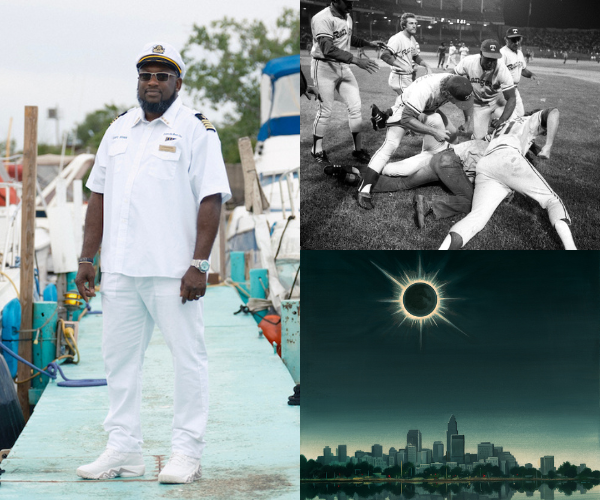The Haunting
Sep. 21, 2004 | 4:00 AM
The house hides behind a green shroud. Dozens of tall, scrawny trees are bunched together on the lot's edge, sprouting leaves only at their tops. The house merely shows what it has to: a tan brick facade behind a long, wooden, wraparound porch. The second floor and attic, sided with chestnut-dark wood, perch up in the trees' shadow, only visible if you walk under the leafy veil.
In the daytime, you could almost dismiss the house as another stately, sturdy piece of history in the 80-year-old neighborhood near Cleveland Heights' Coventry Road. Except that the windows are blotted out by black garbage bags, layered dust, disheveled blinds and stained curtains with faded, generations-old patterns. Looking at them, I figure the rumor must be true: No one's lived in the house for 40 years.
A few months after I moved to Cleveland Heights, a friend told me the legend of the "haunted" house near Coventry. "Someone's will prevents the place from being sold," he said the story went. One bedroom light is always on. "Someone takes good care of the place. Roofers once came but were spooked after four hours and left. If you look in the mail slot, there are mannequins."
I looked at the address — around the block from me — and felt the tingling thrill of a great mystery. I don't believe in ghosts, but I can suspend my disbelief to enjoy a ghost story. Besides, I'm curious about urban legends and the stories behind them.
I set out for some evening walks past the house. Once, just before dark, I saw why the house appealed to legend-tellers' imaginations. A light glowed in a second-floor window, the classic horror-movie sign of an undead presence. It looked like a bare bulb eerily diffused by an orange curtain.
Farther down the street, other houses' bright, eccentric paint jobs — pink, blue, red — cheerily reflected the day's last light. Turning around, I couldn't see the empty house anymore. The trees blocked out the sun.
A friend of a friend heard about my quest and e-mailed me. "I would love to help," she wrote. "I love spooky things."
A few evenings later, we walked to the house, debating which parts of the legend might be true. Why would anyone prevent their house from being sold after they died? Was the front hall really full of mannequins? How creepy would that be — a house with only fake people in it?
"Those second-floor blinds look like someone's been peeking out," she said. They just looked scattered and neglected to me, but I admired her ability to spook herself.
Our footsteps resounded as heavy thumps on the warped wooden porch. I knelt down at the mail slot. "Managed service point," read a fading post-office sticker; someone had been forwarding the mail for a long time.
I lifted the slot and the musty scent of age and dust wafted out. I couldn't see anything, so we got a flashlight and came back. I poked the light into the slot and saw legs.
Two fake legs. Short, fake legs. A child mannequin?
"I think it's a lawn jockey," I said. It was the house's first lesson in the half-truth of legends. Near the jockey's feet lay paint cans and rags.
On my walks, I started asking neighbors about the house. Most complained about the high-school and college kids who come by in the middle of the night for a scare.
"This whole B.S. legend thing about it being haunted leads kids to come here, smoke pot and have sex with their girlfriends," groused one neighbor, who calls the police on the trespassers. Keeping the house empty is "irresponsible," he fumed.
Another neighbor, who I heard had befriended the owner, defended him with the zeal and legalese of a civil-libertarian lawyer (though he says he's not an attorney). "In the United States, property owners are allowed to do whatever they want with their property," he said. "He maintains it, the property, such that it in no way infringes or abridges any of the community's property rights."
Most neighbors shrugged. The kids' late-night scare trips were mildly annoying and they'd rather have a neighbor, but it was no big deal.
A woman said the house had been empty since at least 1967, when her family moved onto the street. According to one rumor, two brothers owned the house, but because their mother died in it, they can't bear to sell it. Another rumor told a different story: The owner has several houses, all empty.
I decided it was time to solve the mystery, so I dug around in county records.
The owner's name is Carl Kornicks. He owns, or is part owner of, nine houses in the eastern suburbs and more than 60 vacant lots throughout Cuyahoga County. Most of his property came from his father, Gus, who started buying land in 1919 and died in 1989.
Gus deeded Carl the house around the block from me in 1965. Nothing in the deed keeps Carl from selling it. Carl's mother, Hilda, died in 1977, a decade after Carl left the house empty, so it's not likely he left it vacant out of mourning.
Cleveland Heights has cited Kornicks six times since 1993 for code violations at the house — boarded or broken windows, peeling paint, broken porch and stair railings and such — but he's always fixed the problems eventually. The city keeps a close watch on vacant houses, explains Rick Wagner, the city's housing-programs manager. Most houses stay vacant for a year or less because of foreclosures or moves. Kornicks' house, says Wagner, is the only one in town that's permanently vacant.
Kornicks (or maybe co-owners) has trouble keeping up with some of his tax payments. Every few years, the county or a financial-services company that buys tax liens sues Kornicks, trying to foreclose on one of his properties. Sometimes, they succeed and force its sale to pay the tax debt.
One morning, I set out to see Kornicks' eight other houses. I found a modest, drab ranch in South Euclid with no garage, a curtain blocking the front-door window and empty rooms visible through the side windows. The guy next door, who'd just moved in, said his real-estate agent told him the ranch is empty because its owner "collects houses."
I also found empty houses in Warrensville Heights and Beachwood — also modest, with no garage. People living nearby said renters used to live in them. (No one mentioned hauntings; the houses were probably too recently vacated and not gothic enough to spook anyone.) Around the corner from the Beachwood house, in another home Kornicks owns, lives his brother, Sam, a co-owner of some of Carl's properties — and a nice guy, a neighbor said. But I couldn't test his friendliness; Sam wasn't home.
Another South Euclid house seemed empty, but I couldn't tell for sure. A nice brick house in University Heights looked occupied: car in the driveway, a banner on the porch.
On a hunch, before I tried Kornicks' home address, I stopped at a house he owns that's still in the phonebook under his dad's name, 15 years after his death. A car sat outside. I knocked.
An elfin man, at least in his 70s, with a wisp of light hair, pale skin, glasses and bewildered hazel eyes answered. He looked surprised that anyone was at his door, as if he'd been left alone for a long time.
I told him I was looking for Carl. "He isn't here," the man said. I told him I lived near Carl's Cleveland Heights house and was writing an article about it, and I wanted to ask him why he'd kept it empty for so long.
The man looked even more stunned. He took my card. "If he's interested, I'll have him call you," he said.
I asked the man his name. He said he had something on the stove and couldn't talk, and started to close the door. I just want to know your name, I said.
"None of your business, my name," he said. The door closed.
I had a feeling I'd just met Carl, especially after I went to his listed address. Huge, overgrown bushes obscured half of the house's facade and walkway. No one answered the door. Curtains blocked all the windows.
The guy next door said he'd met the owner once in three years. He described him and his car, and it sounded like the man I'd just met.
Carl and Sam haven't returned my calls or letters. So the last mystery about the house is hidden in Carl's mind: why he won't sell or rent his properties, why he lets them become dead zones on nice streets. But there's no mystery to me anymore about why there's something haunting about the house.
In a way, Cleveland is filled with ghosts, but we've replaced them. Whoever lived in my apartment when it was new in the 1920s is probably dead, but moving vans pull up to the building every month, bringing new life stories. Coventry has changed from a sensible business district to three blocks crammed with creativity and culture. The big old houses nearby have filled up with people tolerant enough that they just roll their eyes when thrill-loving college students come screaming down their street. But in the middle of the neighborhood stands the haunting house, the house that scares us because it won't replace old souls with new, because its yellowed, fraying curtains remind us that some places and families get lost in the past and that some things just end.
Trending
-
1
-
2
-
3
-
4
-
5










